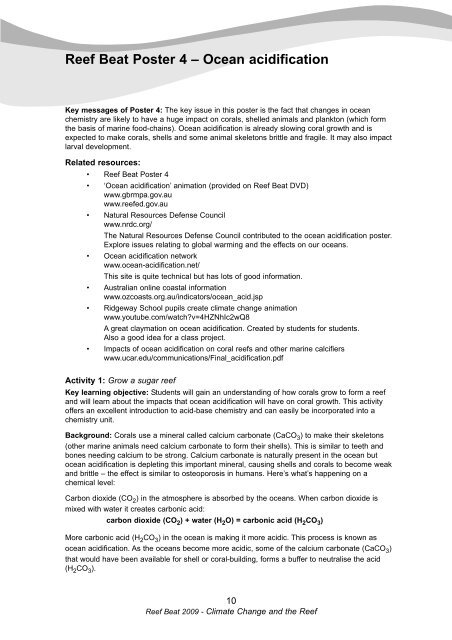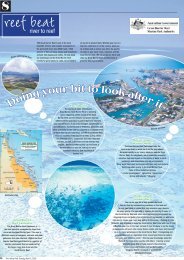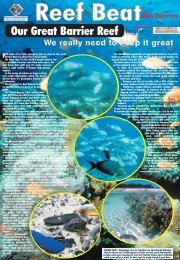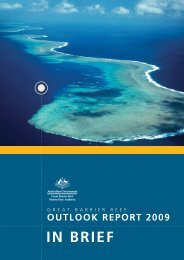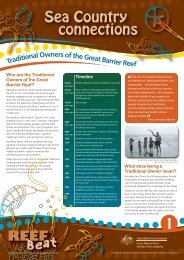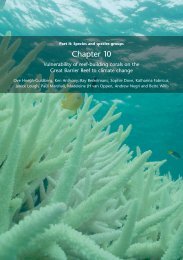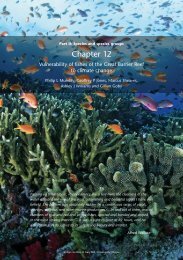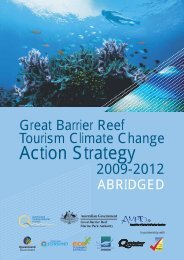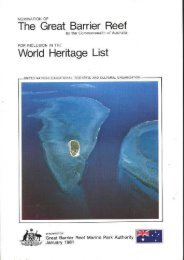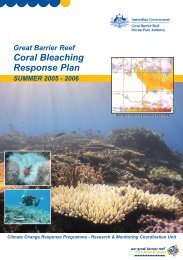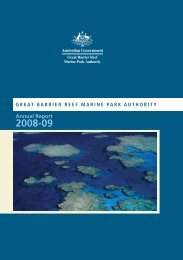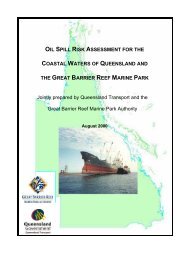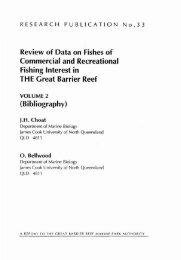ACTIVITIES BOOK - Great Barrier Reef Marine Park Authority
ACTIVITIES BOOK - Great Barrier Reef Marine Park Authority
ACTIVITIES BOOK - Great Barrier Reef Marine Park Authority
Create successful ePaper yourself
Turn your PDF publications into a flip-book with our unique Google optimized e-Paper software.
<strong>Reef</strong> Beat Poster 4 – Ocean acidificationKey messages of Poster 4: The key issue in this poster is the fact that changes in oceanchemistry are likely to have a huge impact on corals, shelled animals and plankton (which formthe basis of marine food-chains). Ocean acidification is already slowing coral growth and isexpected to make corals, shells and some animal skeletons brittle and fragile. It may also impactlarval development.Related resources:• <strong>Reef</strong> Beat Poster 4• ‘Ocean acidification’ animation (provided on <strong>Reef</strong> Beat DVD)www.gbrmpa.gov.auwww.reefed.gov.au• Natural Resources Defense Councilwww.nrdc.org/The Natural Resources Defense Council contributed to the ocean acidification poster.Explore issues relating to global warming and the effects on our oceans.• Ocean acidification networkwww.ocean-acidification.net/This site is quite technical but has lots of good information.• Australian online coastal informationwww.ozcoasts.org.au/indicators/ocean_acid.jsp• Ridgeway School pupils create climate change animationwww.youtube.com/watch?v=4HZNhIc2wQ8A great claymation on ocean acidification. Created by students for students.Also a good idea for a class project.• Impacts of ocean acidification on coral reefs and other marine calcifierswww.ucar.edu/communications/Final_acidification.pdfActivity 1: Grow a sugar reefKey learning objective: Students will gain an understanding of how corals grow to form a reefand will learn about the impacts that ocean acidification will have on coral growth. This activityoffers an excellent introduction to acid-base chemistry and can easily be incorporated into achemistry unit.Background: Corals use a mineral called calcium carbonate (CaCO 3 ) to make their skeletons(other marine animals need calcium carbonate to form their shells). This is similar to teeth andbones needing calcium to be strong. Calcium carbonate is naturally present in the ocean butocean acidification is depleting this important mineral, causing shells and corals to become weakand brittle – the effect is similar to osteoporosis in humans. Here’s what’s happening on achemical level:Carbon dioxide (CO 2 ) in the atmosphere is absorbed by the oceans. When carbon dioxide ismixed with water it creates carbonic acid:carbon dioxide (CO 2 ) + water (H 2 O) = carbonic acid (H 2 CO 3 )More carbonic acid (H 2 CO 3 ) in the ocean is making it more acidic. This process is known asocean acidification. As the oceans become more acidic, some of the calcium carbonate (CaCO 3 )that would have been available for shell or coral-building, forms a buffer to neutralise the acid(H 2 CO 3 ).10<strong>Reef</strong> Beat 2009 - Climate Change and the <strong>Reef</strong>


